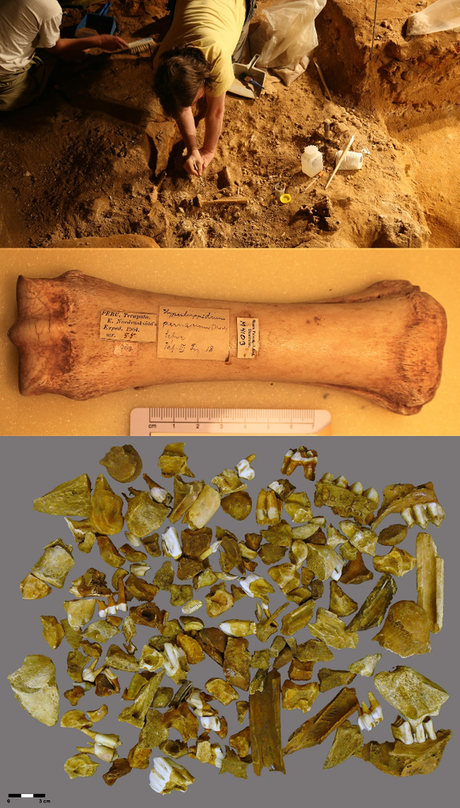
Scientists have widely been interested in the present and future state of biodiversity. Ecologists (the main audience of this blog) have also looked into the past with pioneering investigations addressing the composition of ancient forests and the origins of agriculture in layers of fossil pollen accumulated in lake sediments [4]. But it took us decades to see the fossil record as a useful tool (combining biological, geochemical and molecular techniques) to answer basic ecological questions. Some of those questions are critical for conserving today's biodiversity [5, 6]: for example, when did human impacts on ecosystems become global or what extinct species have best tolerated past environmental change and what that means to modern species? [7].
The study of (pre)historic biological events relies one way or another on our ability to time when a certain animal, human, or plant occurred and what environmental conditions they experienced, and relies on concepts borrowed from archaeology (past human activity), palaeontology (fossils), palaeocology (species responses to past environments), and geochronology (age of fossils and/or their geological context). Among the range of chronological methods available to date biological and cultural samples [8], radiocarbon ( 14C) dating has become the most important for dating bones aged modern to late Quaternary (last ~ 50,000 years).Hereafter, 'bone' comprises antler, bone, ivory and teeth. 14 C dating of bones is appealing at least for four reasons:
- Conceptually simple (see video here): the more 14C found in a bone, the younger the bone. Counting 14C atoms by accelerator mass spectrometry (AMS, see the guts of an accelerator here) has outcompeted the original method of counting beta particles (measuring radioactivity, still used by some 14C laboratories) conceived by Willard Libby.
- Low-mass samples: we can date bone samples below 1 g, a crucial factor for a fragmented fossil record frequently represented by a single, incomplete bone per specimen (see video on how bones fossilise).
- Direct: if one is interested in timing when a species existed, directly dating a bone will often be more accurate than indirectly dating the surrounding soils and sediments, because fossils are frequently found outside the geological context of the death of the individual to which the bones belonged.
- Universal: more than 150 AMS facilitates are doing 14C dating throughout the world, so the method is widely available wherever scientists do their work.
Most ages of fossil bone generated at modern AMS 14C laboratories are estimated from collagen (a fibrillary protein with three strands of amino acids twisted together like a rope). However, fossil collagen is not chemically inert but incorporates carbon from the environment (soil, sediment, rain, ground water) [9, 10]. AMS accelerators cannot differentiate 14C atoms belonging to a fossil bone from 14C atoms that bone has taken up from the environment. Imagine we are counting white beans in a plastic bag: we cannot tell whether different beans came from different plants, orchards, regions or countries; they are just beans as much as 14C atoms in a fossil bone are just 14C atoms. Contamination with foreign 14C can cause errors in the estimation of the geological age of a bone by tens to thousands of years, potentially distorting downstream inferences like what climatic conditions (measured through a palaeoclimate archive) align with a species' extinction time (quantified from a time series of 14 C dates). Therefore, prior to dating, collagen is subjected to four major purification steps - collectively known as 'pretreatment', which I summarise in the following panel.
increasing accuracy, complexity, cost & turnaround; decreasing datable mass/sample →
chemistryremoval of mineral (apatite) in cold acid, then heating in slightly acidic water resulting in collagen gelatingelatin filtered through a 30 kDalton (kDa) membranegelatin broken into free amino acids in strong acid & passed through a non-polar XAD resin that binds to contaminantsgelatin broken into free amino acids in acid & passed through a chromatographic column isolating hydroxyproline by its structure rationaleapatite more prone to uptake carbon contaminants than collagenlarge molecules are collagen; small molecules are contaminantsamino acids are free of contaminants; collagen is nothydroxyproline is specific to bone My paper was accepted for publication last December 2020, only days before moving from Australia to Spain. I thank my dear colleagues at the Australian Centre for Ancient DNA () for the inspiring exchanges we have shared in the last three years. I also appreciate the supreme feedback provided by Matthew Collins, Dizzy Gillespie, and Tom Stafford during the conception and writing of the paper.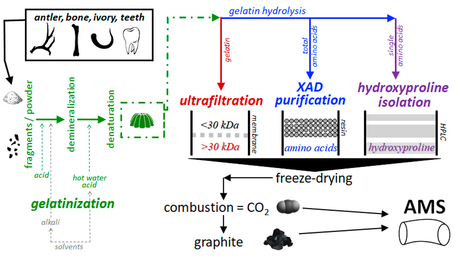
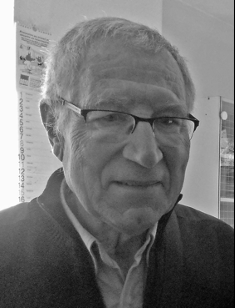
Robert Longin
Gelatinization is the minimum, if not final, pretreatment offered by the vast majority of laboratories.
It mimics an ancient culinary trick: slow simmering of bone in hot water dissolves collagen and produces a nutritious bone broth (gelatin).
Adapted for 14C dating by Robert Longin as part of his PhD thesis at the University of Lyon (France) and published in Nature in 1971 [11].

Erle Nelson
Ultrafiltration is the most popular pretreatment of collagen gelatin these days.
Developed in the 1980s by Erle Nelson at Simon Fraser University (Canada) [12], used by several AMS labs in North America since the 1990s, and introduced to Europe through Mike Richards' PhD and first postdoc at Oxford University.
The Oxford Radiocarbon Accelerator Unit ( ORAU) adopted ultrafiltration in June 2000, and other European labs followed at least 6 years later.

Thomas Stafford, Jr.
XAD purification uses non-polar resins that specifically bind to contaminants after the collagen gelatine has been hydrolysed to free amino acids.
Developed by Tom Stafford in the 1980s [13, 15], it features in the menu of 14C services offered by several North American AMS laboratories.
The method has surprisingly not reached European facilities.
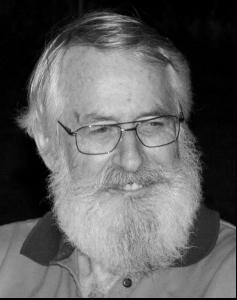
Richard (Dizzy) Gillespie
Dating hydroxyproline was hinted at in the 1960s [16] but Dizzy Gillespie was the first author to publish 14C dates using hydroxyproline isolation in 1984 [14].
This pretreatment uses liquid chromatography to isolate individual amino acids (hydrolysed from collagen) by their structure.
Hydroxyproline is an imino (or secondary) amino acid that animals produce in vivo (metabolically, not from the diet).
Questionnaire survey
I have spent > 3 years collating 14C dates from the scientific literature almost daily [e.g., 17]. Throughout, I have discovered that bone pretreatment is often not reported by authors publishing 14C dates. Finding this information becomes a detective task that I will discuss in a future post. My focus here is that ( i) if different 14C laboratories offer different pretreatments, and ( ii) if different pretreatments (sometimes the same pretreatment run by different laboratories) can produce different 14C ages of the same bone, and ( iii) given that there are no universal guidelines about what pretreatment should be best for what sample, then neglecting the chemistry of how a 14C date has been generated eludes a critical criterion to rank the quality of 14 C data. We currently lack a comprehensive assessment and quantification of the magnitude of this problem in published research.
With that concern in mind, I conceived my study. I asked 132 researchers, who use, generate and/or publish 14C dates of human and megafauna bones, to answer 12 questions about their preferences and concerns about the four most widespread pretreatments of collagen leading to AMS 14C dating (gelatinisation optionally followed by ultrafiltration, XAD purification or hydroxyproline isolation). I wanted to know the degree of consensus among top researchers in their fields (particularly archaeologists, palaeontologists and geochronologists), working at world-class research sites and/or AMS laboratories worldwide (25 countries). The research paper has been published open-access here, including main text (pdf), questionnaire design (html) + respondents' raw responses (xlsx)+ supplementary figures and tables (pdf). A talk I gave in February 2020 in the Flinders University Ecology and Evolution Seminar Series about this work is available here.
The questionnaire survey revealed that, for dating bone suspected to be severely contaminated with foreign carbon, hydroxyproline isolation is the preferred chemical option (39% of the respondents), followed by ultrafiltration (23%), XAD purification (9%), and gelatinisation alone (<5%). 23% of the audience was unsure of the reliability of what pretreatment to rank first. Before submitting bone samples to a 14C laboratory, both contamination and the international prestige of 14C laboratories are the top-ranked criteria respondents ponder to choose pretreatment. And, one in every two respondents who submit bone samples for dating to a 14C laboratory do not choose pretreatment themselves but ask or let the 14 C laboratory select pretreatment for them.
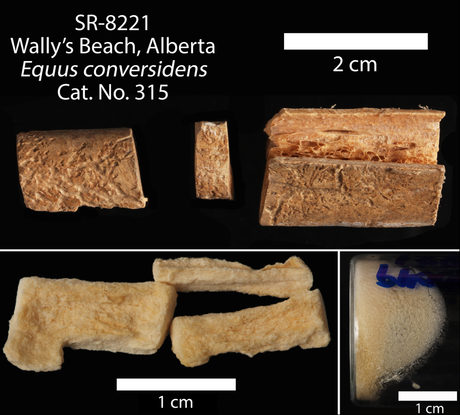
In my paper, I complemented the questionnaire survey with a literature review of bone-contamination issues for 14 C dating. I propose the following three areas of future development:
- Universal standards: A certification agency seems much needed to oversee quality control across laboratories. The overarching principles of such an agency could be to enforce procedural consistency across 14C laboratories, to promote a network of research sites specialising on specific aspects of dating (e.g., types of samples like bone, charcoal, shell, etc.), and to supervise and speed up the transfer of chemistry developments from research to application at 14C laboratories.
- Affordable accuracy: Molecular-level (primary and secondary amino acids) dating is expensive (costly reagents, equipment, highly skilled personnel) and not widely available. We need to make current protocols cheaper, and/or to develop alternative, affordable chemical protocols to isolate and date amino acids. Genomics illustrate that innovation cheapens technology and cheaper technology triggers innovation, so sequencing a genome has plummeted from US$100M to US$1K in 20 years.
- Collective effort: Researchers must be more conceptually involved in how 14C data are generated, and journal Editors should not accept research manuscripts using 14C data without clear and replicable data-quality filters (including sample pretreatment). Provoking paper titles like "big data little help in megafauna mysteries" with regard to Quaternary extinctions [20] convey the message that data quality is as important as the most sophisticated modelling to make global inferences about past biological events.
During peer review
Before my successful submission to Royal Society Open Science (RSOS), my manuscript was rejected at the Editorial level three times for the following reasons: ( i) "your manuscript falls outside the scope of this journal" ( Scientific Reports, decision date = 20/07/2020), ( ii) "not convinced that the findings presented have the potential significance for publication in eLife" (28/07/2020), and ( iii) "not feel that your study represents the strength of advance that we require for publication in PLoS Biology" (29/05/2020). Of course, I hold no grudge against those decisions - rejections are normal outcomes in a scientist's work. But the above rationale of rejection contradicts the facts that ( i) these journals publish research built on 14C dates and ( ii) 14 C dating is propelling advances in multiple scientific disciplines [21]. After all: what can be more important for scientific research than finessing data quality?
One of the two RSOS reviewers pondered that "I worry that it [my article] will scare potential users of radiocarbon labs into never attempting to radiocarbon date bone" ( RSOS has made reviewers' comments and my responses to them available here). I conclude this blog with my answer to that statement:
The overarching goal of my manuscript is to promote improvements rather than discrediting the field of 14C dating. In that direction, I have now emphasised the critical (current/future) role of 14 C dating in scientific research in the concluding section of my article:
" 14 C dating has meritoriously established itself as one of the most powerful tools for dating cultural and palaeontological deposits from the late Quaternary [22, 23]. The method is conceptually simple and well understood. Along with its prominence in the Quaternary sciences, its importance in modern research has been, and will be even more, heightened by the growing application of palaeoarchives and fossil materials to understand ongoing global ecosystem shifts and anthropogenic impacts on biodiversity and the environment [5, 6]."
Acknowledgements
I thank the 132 authors who participated in the questionnaire survey, and Alex Bayliss, Corey Bradshaw, Tom Higham, Greg McDonald, Kieren Mitchell, Paula Reimer, Mike Richards, John Southon and Chris Turney for their generous input at different stages of conception and completion of my study. Photographs kindly provided by Estevan Álvarez-Fernández (Cervus), Gavin Prideaux (Procoptodon), Tom Stafford (Equus), Natalia Villavicencio (Hippidion), Christine Oberlin (Robert Longin) and Mike Richards (Erle Nelson). My salary was funded by Australian Research Council Discovery Project DP170104665, and publication fees were paid by the School of Biological Sciences (University of Adelaide, Australia).
References
[2] Villavicencio, Werdelin 2018 The Casa del Diablo cave (Puno, Peru) and the late Pleistocene demise of megafauna in the Andean Altiplano. Quaternary Science Reviews 195: 21-31 doi:10.1016/j.quascirev.2018.07.013
[4] Moore 1986 Palaeoecology: unravelling human effects. Nature 321: 204 doi:10.1038/321204a0
[5] Dietl, Flessa 2011 Conservation paleobiology: putting the dead to work. Trends in Ecology & Evolution 26: 30-37 doi:10.1016/j.tree.2010.09.010
[8] Walker 2005 Quaternary dating methods. Chichester, West Sussex, England: Wiley.
[11] Longin 1971 New method of collagen extraction for radiocarbon dating. Nature 230: 241-242 doi:10.1038/230241a0
[21] Marra 2019 Hot carbon: carbon-14 and a revolution in science. New York, USA: Columbia University Press.
[23] Taylor, Bar-Yosef 2016 Radiocarbon dating. An archaeological perspective. New York, USA: Routledge.

